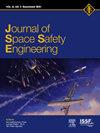在地球同步轨道避免碰撞:通过地面光学观测确定电力推进卫星被动轨道的操作方法
IF 1.7
Q3 ENGINEERING, AEROSPACE
引用次数: 0
摘要
SICRAL联合管理& &;控制中心(SJMCC)是负责意大利军用航天器任务控制的一个意大利军事机构,也是能够独立执行航天器内务管理和空间站保持业务的第一个欧洲全军事机构。在这方面,最重要的活动之一是管理碰撞风险。该任务通过确定次要目标(如相邻的地球同步卫星)的轨道和评估轨道参数来完成,以评估避碰机动的必要性。近年来,配备了基于电动推进器的创新推进系统的新一代卫星给上述操作带来了新的挑战。与化学推进相比,电力推进系统提供了非常高的推力效率和低油耗,同时通常满足于较低的推力水平和较长的机动时间。这意味着航天器的自由动力学行为仅局限于轨道周期的一小部分。因此,基于得到的状态向量传播的典型飞行动力学方法失去了其内部值,因为电力推进航天器仅在其轨道周期的有限部分内持续处于自由动力学状态。从任务控制中心(如SJMCC)的角度来看,这些新卫星使其有必要大幅调整其轨道确定能力。因此,研究的主要目标是建立一种管理电力推进地球静止卫星轨道确定的策略和工具模型。本文详细介绍了一个名为“连续Obit Determination”(COD)的创新概念,并提出了一种基于开源库的可能的软件实现。为了评估电力推进卫星给卫星控制中心带来的挑战,COD被详细描述为一种强大的策略,能够灵活地聚合二次卫星的不同观测数据,以找到最佳的拟合解决方案。轨道之间的比较可以描述卫星的机动策略并选择最精确的轨道。最后,利用SJMCC管理的“CAS望远镜”的避碰观测数据,对研究结果进行了实验验证。本文章由计算机程序翻译,如有差异,请以英文原文为准。
Collision avoidance in GEO: An operational approach to passive orbit determination for electric propulsion satellites via optical ground based observations
The SICRAL Joint Management & Control Centre (SJMCC) is an Italian military institution in charge of the mission control of the Italian military spacecraft and the first European full-military institute capable of independently performing spacecraft housekeeping and station keeping operations. In this context, one of the most important activities is the management of collision risks. The task is accomplished by determining the orbits of secondary objects (such as neighbouring geostationary satellites) and evaluating the orbital parameters, in order to assess the necessity of a collision avoidance maneuver. In recent years, a new generation of satellites equipped with innovative propulsion systems based on electric thrusters has introduced new challenges to the aforementioned operation. Electric propulsion systems provide very high thrust efficiency and low fuel consumption compared to chemical propulsion, while generically settling for lower thrust levels and longer maneuvering times. This implies that the free dynamics behaviour of the spacecraft is only confined to a short fraction of the orbital period. Consequently, the typical flight dynamics approach, based on the propagation of the obtained state vector, loses its inner value since the electric propulsion spacecraft will persist in a free dynamics regime only for a limited fraction of its orbital period. From the perspective of a mission control centre, such as SJMCC, these new satellites make it necessary to drastically adapt its orbit determination capabilities. Consequently, the main goal of the research has been to model a strategy and a tool to manage the orbit determination of electric propulsion geostationary satellites. The paper thoroughly describes an innovative concept named “Continuous Obit Determination” (COD), also presenting a possible software implementation based on open-source libraries. Evaluating the challenges that electric propulsion satellites bring to satellite control centres, COD is detailed as a robust strategy able to flexibly aggregate different observational data of the secondary satellite in order to find the best fitting solution. The comparison between orbits allows the delineation of the satellite's maneuvering strategy and the selection of the most accurate orbit. Finally, the research results have been experimentally validated through observational data acquired via the “CAS telescope” managed by SJMCC for collision avoidance purposes.
求助全文
通过发布文献求助,成功后即可免费获取论文全文。
去求助
来源期刊

Journal of Space Safety Engineering
Engineering-Safety, Risk, Reliability and Quality
CiteScore
2.50
自引率
0.00%
发文量
80
 求助内容:
求助内容: 应助结果提醒方式:
应助结果提醒方式:


